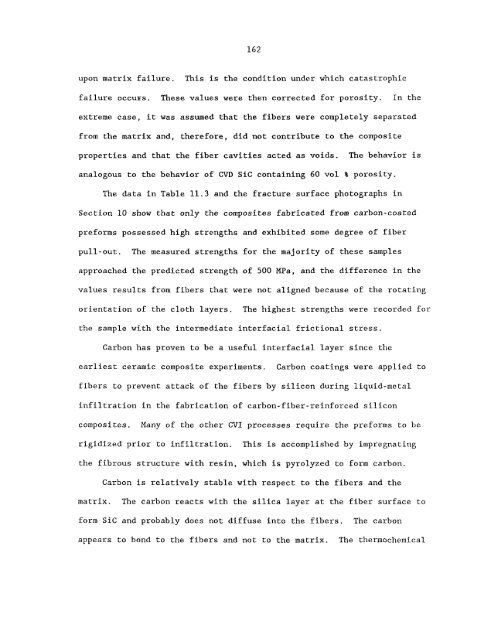Characterization and control of the fiber-matrix interface in ceramic ...
Characterization and control of the fiber-matrix interface in ceramic ...
Characterization and control of the fiber-matrix interface in ceramic ...
You also want an ePaper? Increase the reach of your titles
YUMPU automatically turns print PDFs into web optimized ePapers that Google loves.
162<br />
upon <strong>matrix</strong> failure.<br />
This is <strong>the</strong> condition under which catastrophic<br />
failure OCCUTS. These values were <strong>the</strong>n corrected for porosity. In <strong>the</strong><br />
extreme case, it was assumed that <strong>the</strong> <strong>fiber</strong>s were completely separated<br />
from <strong>the</strong> <strong>matrix</strong> <strong>and</strong>, <strong>the</strong>refore, did not contribute to <strong>the</strong> composite<br />
properties <strong>and</strong> that <strong>the</strong> <strong>fiber</strong> cavities acted as voids.<br />
analogous to <strong>the</strong> behavior <strong>of</strong> CVD Sic conta<strong>in</strong><strong>in</strong>g 60 vol %<br />
The behavior is<br />
porosity.<br />
The data <strong>in</strong> Table 11.3 <strong>and</strong> <strong>the</strong> fracture surface photographs <strong>in</strong><br />
Section 10 show that only <strong>the</strong> composites fabricated from carbon-coated<br />
preforms possessed high strengths <strong>and</strong> exhibited some degree <strong>of</strong> <strong>fiber</strong><br />
pull-out.<br />
The measured strengths for <strong>the</strong> majority <strong>of</strong> <strong>the</strong>se samples<br />
approached <strong>the</strong> predicted strength <strong>of</strong> 500 MPa, <strong>and</strong> <strong>the</strong> difference <strong>in</strong> <strong>the</strong><br />
values results from <strong>fiber</strong>s that were not aligned because <strong>of</strong> <strong>the</strong> rotat<strong>in</strong>g<br />
orientation <strong>of</strong> <strong>the</strong> cloth layers.<br />
The highest strengths were recorded for<br />
<strong>the</strong> sample with <strong>the</strong> <strong>in</strong>termediate <strong>in</strong>terfacial frictional stress.<br />
Carbon has proven to be a useful <strong>in</strong>terfacial layer s<strong>in</strong>ce <strong>the</strong><br />
earliest <strong>ceramic</strong> composite experiments.<br />
Carbon coat<strong>in</strong>gs were applied to<br />
<strong>fiber</strong>s to prevent attack <strong>of</strong> <strong>the</strong> <strong>fiber</strong>s by silicon dur<strong>in</strong>g liquid-metal<br />
<strong>in</strong>filtration <strong>in</strong> <strong>the</strong> fabrication <strong>of</strong> carbon-<strong>fiber</strong>-re<strong>in</strong>forced silicon<br />
Composites.<br />
Many <strong>of</strong> <strong>the</strong> o<strong>the</strong>r CVI processes require <strong>the</strong> preforms to be<br />
rigidized prior to <strong>in</strong>filtration.<br />
This is accomplished by impregnat<strong>in</strong>g<br />
<strong>the</strong> fibrous structure with res<strong>in</strong>, which is pyrolyzed to form carbon.<br />
Carbon is relatively stable with respect to <strong>the</strong> <strong>fiber</strong>s <strong>and</strong> <strong>the</strong><br />
<strong>matrix</strong>.<br />
The carbon reacts with <strong>the</strong> silica layer at <strong>the</strong> <strong>fiber</strong> surface to<br />
form Sic <strong>and</strong> probably does not diffuse <strong>in</strong>to <strong>the</strong> <strong>fiber</strong>s.<br />
The carbon<br />
appears to bond to <strong>the</strong> <strong>fiber</strong>s <strong>and</strong> not to <strong>the</strong> <strong>matrix</strong>.<br />
The <strong>the</strong>rmochemical

















